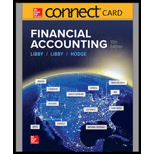
Concept explainers
1.
Record the sale of the bonds
1.
Explanation of Solution
Bonds:
Bonds are a kind of interest bearing notes payable, usually issued by companies, universities and governmental organizations. It is a debt instrument used for the purpose of raising fund of the corporations or governmental agencies. If selling price of the bond is equal to its face value, it is called as par on bond. If selling price of the bond is lesser than the face value, it is known as discount on bond. If selling price of the bond is greater than the face value, it is known as premium on bond.
Prepare
| Date | Account Titles and Explanation |
Debit ($) |
Credit ($) |
| Cash (1) | 1,135,907 | ||
| Premium on bonds payable (5) | 135,907 | ||
| Bonds payable | 1,000,000 | ||
| (To record the sale of bonds ) |
Table (1)
- Cash is an asset and it is increased. Therefore debit cash account by 1,135,907
- Premium on bonds payable is an adjunct liability and it is increased. Therefore credit premium on bonds payable by $135,907
- Bonds payable is a liability and it is increased. Therefore credit bonds payable by $1,000,000.
Prepare journal entry to record the sale of bonds without using a premium account.
| Date | Account Titles and Explanation |
Debit ($) |
Credit ($) |
| Cash (1) | 1,135,907 | ||
| Bonds payable | 1,135,907 | ||
| (To record the sale of bonds ) |
Table (2)
- Cash is an asset and it is increased. Therefore debit cash account by 1,135,907
- Bonds payable is a liability and it is increased. Therefore credit bonds payable by $1,135,907.
Working notes:
Calculate the issue price of bonds:
| Particulars | Amount ($) |
| Interest amount (2) | 50,000 |
| Present value of principal amount (3) | 456,390 |
| Present value of interest expense amount (4) | 679,517 |
| Issue price | 1,135,907 |
Table (3)
(1)
Calculate the Interest expense amount:
Calculate present value of principal amount.
Calculate present value of interest expense amount.
Calculate the premium on bonds payable:
2.
Record the issuance of stock
2.
Explanation of Solution
Issuance of stock:
It refers to the number of shares that are sold to the stockholders from number of shares authorized for issuance by the company.
Prepare journal entry to record issuance of stock.
| Date | Account Titles and Explanation | Debit ($) | Credit ($) |
| Cash (6) | 1,125,000 | ||
| Common stock (7) | 45,000 | ||
| Additional paid-in capital | 1,080,000 | ||
| (To record the issuance of stock) |
Table (4)
- Cash is an asset and it is increased. Therefore debit cash account by $1,125,000
- Common stock is a component of
stockholders equity and it is increased. Therefore, credittreasury stock by $45,000 - Additional paid-in capital is a component of stockholders equity and it is increased. Therefore, credit additional paid-in capital by $1,080,000.
Working notes:
Calculate the value of cash:
Calculate the value of common stock:
Want to see more full solutions like this?
Chapter 11 Solutions
Connect Access Card For Financial Accounting
- Inventory Valuation (FIFO Method)A company had the following inventory transactions during the month: Beginning inventory: 100 units @ $10 eachPurchase: 200 units @ $12 eachPurchase: 150 units @ $13 eachAt the end of the month, 250 units remain in inventory. Calculate the value of the ending inventory using the FIFO method. explainarrow_forwardNeed assistance without use of ai.arrow_forwardDepreciation (Straight-Line Method)A company purchases machinery for $50,000. The estimated salvage value is $5,000, and the useful life is 10 years. a) Calculate the annual depreciation expense.b) What will the book value of the machinery be after 4 years?arrow_forward
- A company has the following data: Cash: $50,000Accounts Receivable: $30,000Inventory: $60,000Current Liabilities: $70,000a) What is the company’s acid-test ratio?b) Is the company in a strong liquidity position based on this ratio?arrow_forwardDon't want AI answerarrow_forwardXYZ Corporation produces a product that sells for $30 per unit. The variable cost per unit is $18. Fixed costs for the year are $72,000. a) What is the contribution margin per unit? b) What is the contribution margin ratio? c) What is the break-even sales in dollars?arrow_forward
- I need solution with step by step....?!arrow_forwardQuestion 1: Break-Even Analysis A company sells a product for $25 per unit. The variable cost per unit is $15, and the total fixed costs are $50,000. a) How many units must the company sell to break even? b) If the company wants a profit of $10,000, how many units must it sell?arrow_forwardNeed this question answer properly.arrow_forward

 AccountingAccountingISBN:9781337272094Author:WARREN, Carl S., Reeve, James M., Duchac, Jonathan E.Publisher:Cengage Learning,
AccountingAccountingISBN:9781337272094Author:WARREN, Carl S., Reeve, James M., Duchac, Jonathan E.Publisher:Cengage Learning, Accounting Information SystemsAccountingISBN:9781337619202Author:Hall, James A.Publisher:Cengage Learning,
Accounting Information SystemsAccountingISBN:9781337619202Author:Hall, James A.Publisher:Cengage Learning, Horngren's Cost Accounting: A Managerial Emphasis...AccountingISBN:9780134475585Author:Srikant M. Datar, Madhav V. RajanPublisher:PEARSON
Horngren's Cost Accounting: A Managerial Emphasis...AccountingISBN:9780134475585Author:Srikant M. Datar, Madhav V. RajanPublisher:PEARSON Intermediate AccountingAccountingISBN:9781259722660Author:J. David Spiceland, Mark W. Nelson, Wayne M ThomasPublisher:McGraw-Hill Education
Intermediate AccountingAccountingISBN:9781259722660Author:J. David Spiceland, Mark W. Nelson, Wayne M ThomasPublisher:McGraw-Hill Education Financial and Managerial AccountingAccountingISBN:9781259726705Author:John J Wild, Ken W. Shaw, Barbara Chiappetta Fundamental Accounting PrinciplesPublisher:McGraw-Hill Education
Financial and Managerial AccountingAccountingISBN:9781259726705Author:John J Wild, Ken W. Shaw, Barbara Chiappetta Fundamental Accounting PrinciplesPublisher:McGraw-Hill Education





